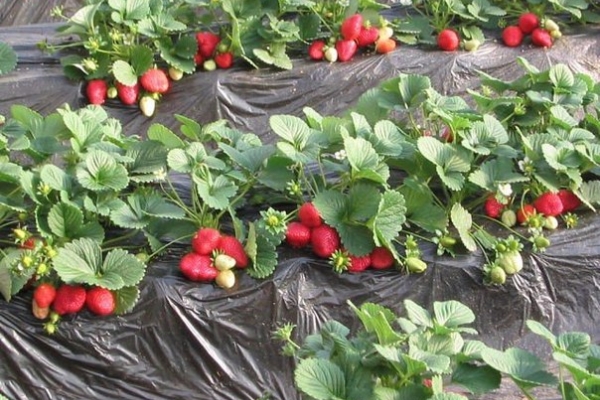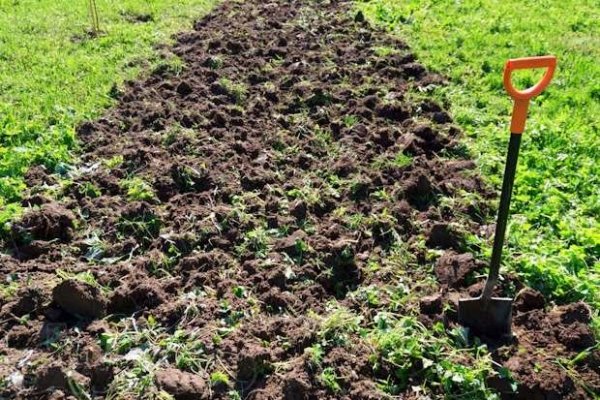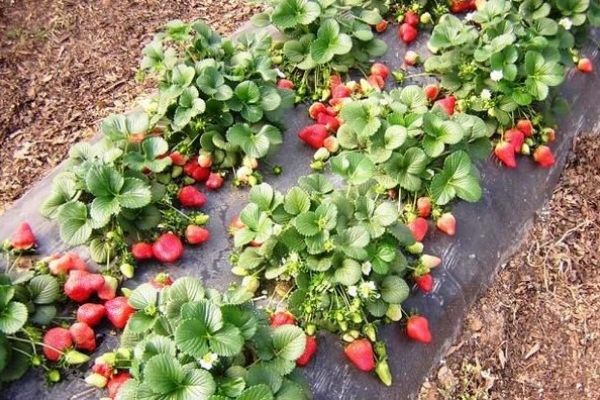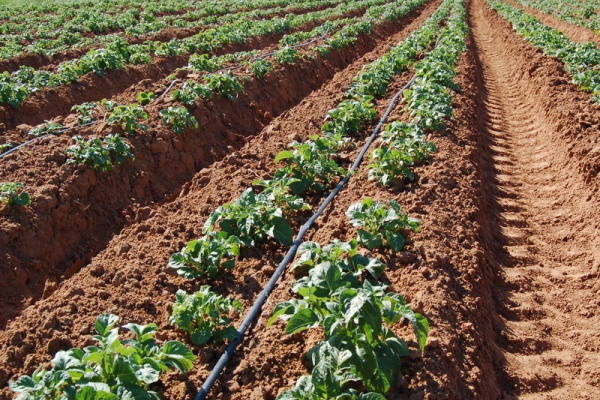Pros of planting strawberries under the covering material
Content
Pros of landing
Planting plants under the covering material greatly facilitates the care of the berries. Therefore, if growing strawberries was previously a very laborious task for you, then mulching will solve the problem.
Everyone wants to enjoy these fragrant and juicy berries. But if you spend a lot of time on leaving, and the harvest is far from expectations, then any desire to grow strawberries disappears. To keep you inspired, there is a great new growing method - mulching. Therefore, the advantages of using a covering material for planting berries should be described in more detail.
- Using black mulching film or black agrofibre for shelter, you can forget about weed control forever, because these materials do not let the sun's rays through at all.
- Mulching allows you to create an optimal microclimate in which the soil will not dry out and weather. On the contrary, it will remain loose and moist. In addition, earthworms are collected under the covering material, which fertilize and loosen the soil - the need for the procedure also disappears.
- Plants grown on a mulch bed will be especially strong and strong, as they form many adventitious roots.
- It will become easier to deal with an extra mustache, since they simply will not have something to gain a foothold on. You just need to take scissors and cut off unnecessary antennae.
- The use of black spunbond allows you to speed up the ripening process of the berries. In addition, strawberries will remain clean even in rainy weather, as there is no contact with the ground. The use of covering materials also prevents berries from rotting, which allows them to maintain their presentation and increase yields.
- Any pests and diseases that are in the soil are not afraid of plants, since the leaves do not come into contact with the soil.
- During winter frosts, even in the absence of snow cover, you will not need to worry that the plants will freeze out. Over the summer, the soil will warm up well and absorb heat, which will remain in the ground for a long time. Therefore, even the spring fluctuation of day and night temperatures will not harm the plants.
Inorganic mulch has a number of advantages over organic covering material - it does not decompose. Organic mulch can soon become a source of multiplication of fungi and bacteria, so planting strawberries under such a covering material does not always meet expectations.
Material selection
There are two types of covering materials for mulching strawberry beds: organic and inorganic.

Pine needles are often used as organic mulch. They help keep the root system from drying out on hot summer days, inhibit the growth of weeds, and serve as a good warming of plants in winter. The use of pine needles gives you the opportunity to enjoy another bonus - the aroma and taste of the berries will noticeably improve. It is noticed that coniferous phytoncides share many useful substances with berries.
You can also mulch strawberry bushes with straw or semi-rotted sawdust.
Straw significantly improves the microflora of the soil due to the multiplication of hay sticks in it, which produces up to eighty useful antibiotics, as well as phytoncides.Therefore, you can forget about root rot forever.
But if you are going to use these materials to shelter plants, remember that they decompose quickly and will soon turn into breeding grounds for fungi and bacteria.

Therefore, despite all the advantages that organic covering material has, many gardeners still prefer inorganic mulch, such as plastic wrap or non-woven material. The color scheme can be different: white, black, two-tone and others.
It is the two-color film that is especially popular, since it consists of two layers: outer (light) and inner (black), and each of them performs its own functions. The light layer prevents overheating of the soil, and thereby creates optimal conditions for the reproduction of earthworms and the development of the root system of plants. In addition, the top layer is able to reflect sunlight that falls on the strawberry bushes and prevents burns on the leaves. The purpose of the inner layer is to prevent the development of weeds and pests.
As for the nonwoven fabric, there are several types of it. Spunbel, spunbond, agrospan, lutrasil are used as mulch for strawberries.
Each of these coatings has its own advantages. German scientists did not sit idle, and the result of their fruitful work was this lightweight durable material of high quality. With its parameters, it surpasses even plastic wrap. The material comes in two colors: black and white. If the former is used mainly for covering greenhouses, then black serves as a mulch cover for strawberries. The use of one layer of material allows you to protect plants from frost down to -2 degrees. If you cover the plants with a double layer, they will not be afraid of even a frost of -7 degrees.

As for agrospan, spunbel, spunbond, these nonwovens are made of polypropylene yarns by thermal bonding. The latest scientific developments are used for their production. Therefore, an ultraviolet stabilizer is introduced into the polymer melt, which enhances the resistance of the covering material to solar radiation, which does not always have a beneficial effect on strawberry bushes.
The service life of spunbel and spunbond is 4 years. It is during this period that the peak yield of the strawberry plantation is observed. After 4 years, it needs to be transplanted, which requires replacing the covering material.
Technology
Before setting up a strawberry plantation, the soil must be prepared: dig up the beds with a shovel, and also remove the weeds. Feed the soil well with humus or manure. Straw is also suitable, as it can simultaneously serve as an organic mulch for strawberries, so when digging up the soil, add that too.

After feeding and moistening the soil, you can start forming high two-row beds. Dig small ditches around the perimeter of the bed (they are needed in order to secure the covering material). The soil must be carefully leveled with a rake.
If you are going to use plastic wrap as a mulch material, then first you need to place a cable irrigation hose on the garden bed.
The covering material must be carefully spread out on the garden bed, while the edges should be fixed gradually, as it rolls out. Try to keep the mulch firmly in the soil.
In order to secure the edges, you can use stones, sandbags, trim boards. You can also just dust them with earth. For a more reliable attachment of agrofibre, it is fashionable to use studs, having previously made them with your own hands from wire of medium thickness. If you are using black spunbond, then keep in mind that its structure is two-sided, and if one of the sides allows water to pass through, then the other, on the contrary, is designed to prevent moisture evaporation.Therefore, when attaching this material, spread it so that the moisture-permeable side is on top.
It is important that the rows of plants come out even. This is not difficult to achieve if you use an ordinary cord for marking. Just stretch it to the full length of your bed, then cut small holes for the young strawberry bushes.

Most gardeners prefer not to complicate the task, and make ordinary cruciform cuts. Others approach this business more responsibly and make small round holes with scissors or a clerical knife. But do not overdo it, we do not need large holes, because weeds can easily break through them through the covering material. The distance between the bushes should be about 30 centimeters, between the rows - up to 40 centimeters.
When you are done with attaching the covering material, you can start planting the bushes. There will be no problems with feeding strawberries, because this can be done easily using the holes in the mulch.
Video "Mulching strawberries with plastic wrap "
The video shows how the strawberry beds are formed with special attachments.


